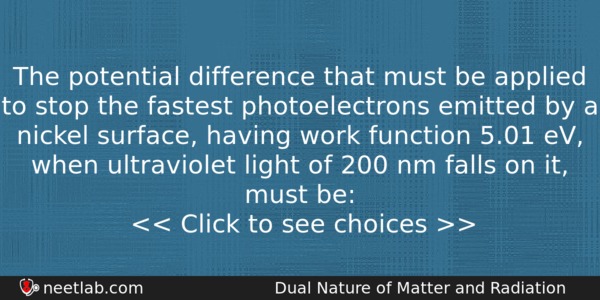| ⇦ | 
| ⇨ |
The potential difference that must be applied to stop the fastest photoelectrons emitted by a nickel surface, having work function 5.01 eV, when ultraviolet light of 200 nm falls on it, must be:
Options
(a) 2.4 V
(b) – 1.2 V
(c) – 2.4 V
(d) 1.2 V
Correct Answer:
1.2 V
Explanation:
Kₘₐₓ = hc / – W = hc / λ – 5.01
= 12375 / λ(in Å) – 5.01
12375 / 2000 – 5.01 = 6.1875 – 5.01 = 1.17775
= 1.2 V
Related Questions: - In the phenomenon of electric discharge through gases at low pressure,
- In an electrical circuit R,L,C and an AC voltage source are all connected in series.
- Three objects A,B and C are kept in a straight line on a frictionless horizontal surface
- An object placed at 20 cm in front of a concave mirror produces three times
- A solid cylinder of mass M and radius R rolls without slipping down and inclined plane
Topics: Dual Nature of Matter and Radiation
(150)
Subject: Physics
(2479)
Important MCQs Based on Medical Entrance Examinations To Improve Your NEET Score
- In the phenomenon of electric discharge through gases at low pressure,
- In an electrical circuit R,L,C and an AC voltage source are all connected in series.
- Three objects A,B and C are kept in a straight line on a frictionless horizontal surface
- An object placed at 20 cm in front of a concave mirror produces three times
- A solid cylinder of mass M and radius R rolls without slipping down and inclined plane
Topics: Dual Nature of Matter and Radiation (150)
Subject: Physics (2479)
Important MCQs Based on Medical Entrance Examinations To Improve Your NEET Score
18000+ students are using NEETLab to improve their score. What about you?
Solve Previous Year MCQs, Mock Tests, Topicwise Practice Tests, Identify Weak Topics, Formula Flash cards and much more is available in NEETLab Android App to improve your NEET score.
Share this page with your friends

Leave a Reply